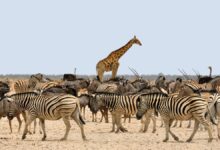Leopards: Stealthy Predator of the Wild

Leopard: A Stealthy Predator of the Wild
Leopard
The leopard is one of the most majestic and elusive big cats in the world. Known for its adaptability, strength, and stealth, this predator roams various terrains, from African savannas to Asian forests. Leopards are expert hunters, using their agility and powerful build to catch prey. Despite being widespread, they are facing increasing threats from habitat loss and human activity.
Scientific Overview
Scientific Name
The scientific name of the leopard is Panthera pardus. This name reflects its classification within the big cat family, sharing a genus with lions, tigers, and jaguars.
Common Name
Leopards are commonly referred to as “leopards,” but some local populations give them specific names depending on their geographic location.
Scientific Classification
| Kingdom | Animalia |
| Phylum | Chordata |
| Class | Mammalia |
| Order | Carnivora |
| Family | Felidae |
| Genus | Panthera |
| Species | Panthera pardus |
Types
There are several subspecies of leopards, including the African leopard (Panthera pardus pardus), the Indian leopard (Panthera pardus fusca), the Arabian leopard (Panthera pardus nimr), and the endangered Amur leopard (Panthera pardus orientalis).
Habitat and Distribution
Habitat
Leopards thrive in various habitats, including savannas, forests, grasslands, deserts, and mountains. Their adaptability allows them to live in both dense rainforests and arid deserts.
Geographic Distribution
They are found across sub-Saharan Africa, parts of the Middle East, and Asia, including India, China, and Southeast Asia. Their broad range makes them one of the most widely distributed big cats.
Physical Characteristics
Size and Weight
Leopards vary in size depending on their geographic location. On average, they weigh between 66 and 176 pounds, with males being larger than females. Their length can range from 4 to 6 feet, excluding the tail.
Appearance
They are known for their distinctive golden-yellow coat covered in black rosettes. These rosettes serve as excellent camouflage in their natural habitats. Their muscular build and retractable claws make them efficient climbers and hunters.
Diet and Feeding Habits
Diet
Leopards are carnivorous predators, feeding on a wide variety of animals. Their diet includes antelope, deer, rodents, birds, and even smaller primates. They are opportunistic hunters, adjusting their prey based on availability.
Feeding Behavior
They are known for their stealthy hunting technique. They stalk their prey silently and pounce at the perfect moment. After catching their prey, they often drag it up a tree to protect it from scavengers like hyenas and lions.
Predators and Threats
Natural Predators
Leopards, as apex predators, have few natural enemies. However, young leopards may fall prey to lions, hyenas, and other larger carnivores.
Human Threats
Human activities pose the greatest threat to leopards. Habitat destruction, poaching for their beautiful coats, and conflicts with livestock farmers have significantly reduced their populations in many areas.
Reproduction, Babies, and Lifespan
Mating Behavior
They are solitary animals, coming together only for mating. The mating season can occur year-round, and the gestation period lasts about 90 to 105 days.
Babies
Female leopards typically give birth to 2-4 cubs, which remain hidden for the first few months of their lives. The mother teaches the cubs how to hunt and survive in the wild.
Lifespan
In the wild, leopards can live up to 12 to 17 years. In captivity, they may live slightly longer, with some individuals reaching over 20 years.

Population and Conservation Status
Population Size
The global population of leopards is declining. Although they are still found in many regions, habitat fragmentation and illegal hunting are driving them toward extinction in some areas.
Conservation Status
They are currently listed as “Vulnerable” on the International Union for Conservation of Nature (IUCN) Red List. Certain subspecies, such as the Amur leopard, are critically endangered, with fewer than 100 individuals remaining in the wild.
Behavior and Lifestyle
Daily Activities
Leopards are nocturnal and solitary creatures. They spend their days resting in trees or secluded areas and become active at dusk to hunt. Their excellent night vision helps them stalk prey in the darkness.
Communication
They communicate through vocalizations, scent marking, and visual cues. Their vocalizations include growls, roars, and a unique rasping cough, used to establish territory or during mating.
Ecological Role
Importance in the Ecosystem
As apex predators, leopards play a crucial role in maintaining the balance of their ecosystems. By controlling the population of herbivores, they prevent overgrazing and ensure biodiversity.
Impact on Humans
While leopards generally avoid humans, they sometimes prey on livestock, leading to conflicts with farmers. Conservation efforts focus on mitigating these conflicts to protect both humans and leopards.
FAQs About Leopards
- Is leopard endangered?
Some leopard subspecies, like the Amur leopard, are critically endangered, while others are listed as vulnerable. - Can leopards climb trees?
Yes, they are excellent climbers and often store their prey in trees. - What do leopards eat?
They primarily eat medium-sized herbivores but are known to be opportunistic feeders. - Where are leopards found?
They are found across Africa and Asia, in diverse habitats like savannas, forests, and deserts. - How long do They live?
In the wild, leopards live for 12 to 17 years, but they can live longer in captivity.
Conclusion
Leopards are one of nature’s most adaptable and skilled predators. Their ability to survive in diverse habitats has made them a widespread species, but increasing human threats put their future at risk. Conservation efforts are essential to protect these magnificent animals and ensure that future generations can witness their beauty and strength in the wild.


